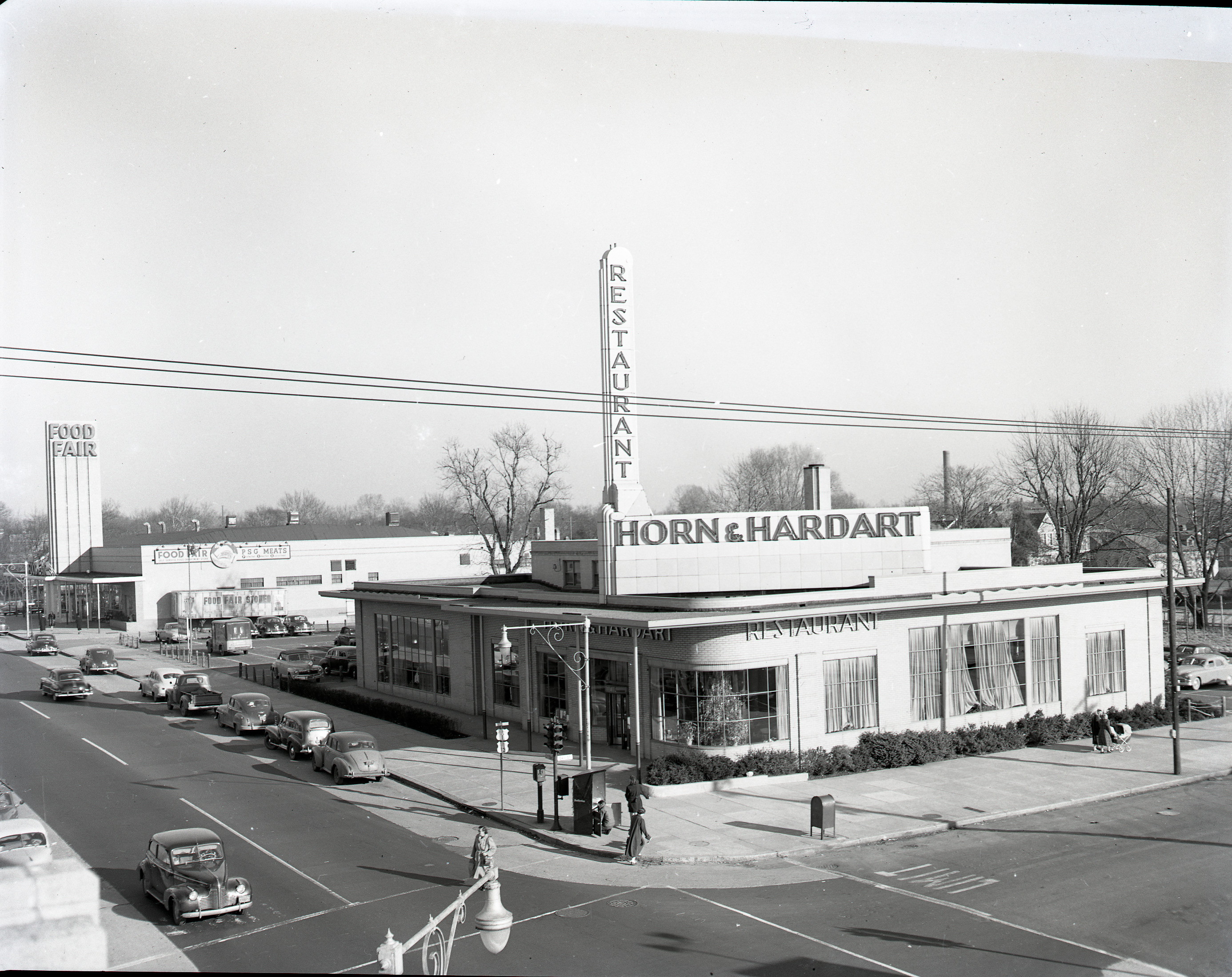-By Jane Roser
Feature image: City Ave. and 54th St., 1949. Image courtesy of Free Library of Philadelphia Print & Picture Collection
Joseph Horn and Frank Hardart opened their first café at 39 South 13th Street in 1888. It had no tables – just a counter and stools. Hardart had visited Europe and was impressed by their “waiter less restaurants.” He bought equipment from the Quisisana Automat Company and together, Horn and Hardart opened the first Automat in Philadelphia at 818 Chestnut Street in 1902. It was an instant phenomenon that would last nearly a hundred years.
The beloved institution is being immortalized in an upcoming documentary feature film directed and produced by Lisa Hurwitz, co-produced by Alec Shuldiner, edited by Michael Levine and Russell Greene. The Automat revisits the iconic restaurant chain using vintage photographs, film reels and interviews with former Horn & Hardart (or as Philadelphians affectionately call it, H&H) employees and famous customers such as Mel Brooks, Carl Reiner, Ruth Bader Ginsburg and Colin Powell.
You can read more about the movie and the history of the Automat in our upcoming July issue. Subscribe here so you can have a copy delivered to your door. In the meantime, check out these interesting facts about the Automat…
- The Philadelphia and New York branches were managed by the same people. They tried to keep quality standards consistent, but the establishments were unique to their location, even serving recipes specific to each demographic.
- Scrapple was popular in Philadelphia, but not in New York. New Yorkers preferred seafood dishes (except oysters) and strong cheeses. Coleslaw and ice cream were popular in Philadelphia. New Yorkers loved clam chowder and chicken pies.
- The automat machines were more popular in New York. In Philadelphia, H&H concentrated on a restaurant style eatery, as opposed to cafeteria.
- One of the best preserved H&H facades is located at 818 Chestnut Street in Philadelphia.
- The first Automat to close did so on December 28, 1968. The last Automat, located on the corner of 42nd Street and Third in Manhattan, closed on April 9, 1991.
- The Automat’s downfall was due to several reasons: the rising popularity of fast food chains, Americans moving out of cities and into the suburbs, the expansion of interstate highways caused people to travel more and eat on the road and families cooking more from home.
- The first H&H opened their first Automat at 818 Chestnut Street in Philadelphia in 1902 and was instantly popular.
- On its first day, the Automat took in 8,693 nickels.
- The Automat was based on the European “waiter-less restaurant” system.
- The first iteration of an automat first appeared in Germany and Scandinavia in the 1890s.
- H&H popularized fresh drip-brewed coffee. In their heyday, they sold over 90 million cups every year which flowed through the mouths of elegantly carved lions or dolphins.
- The first Automat in New York opened in 1912 on Times Square.
- The chain operated almost 50 locations in Philadelphia and over 100 in New York.
- The Mazzone family were able to duplicate the original H&H coffee blend which you can buy here: www.hornandhardartcoffee.com.
- To maintain quality, food preparation was moved to a central commissary at 202 S. Tenth Street.
- The interior of the Automat at 818 Chestnut Street was donated to the National Museum of American History, Smithsonian Institution, Washington DC.
- The last H&H located in Philadelphia (Bala Cynwyd) closed on May 12, 1990.
- By 1940 H&H fed 7000,000 people a day.
- The women who changed customers’ bills into the nickels needed for the Automat machines were affectionately called “nickel-throwers”.
- By 1932 H&H had 46 restaurants in Philadelphia, only a small percentage of which were Automats.
- During its heyday a cup of coffee would set you back a nickel. A slice of pie was a dime and a full three course meal was 50 cents.
- Standards from the Managers’ Instruction Book included “do not slice bananas in advance as they discolor rapidly”, “Cakes: Display in rush periods; make up no more than six orders at a time to avoid stale product” and “Coffee: First draw and throw away about 2oz. because coffee lying in the faucet absorbs a metallic flavor”.
- 1n 1906 H&H’s chief engineer, John Fritsche, filed a patent for a “vending machine” which, after a few updates in 1911, eventually became the technology the company used for the next 80 years.
Sources:
- “Trapped Behind the Automat: Technological Systems and the American Restaurant, 1902-1991”, 2001 dissertation by Dr. Alec Shuldiner
- “All Gone: Things That Aren’t There Anymore” by David Seidman
- “Automats” article by Dr. Stephen Nepa
- “How Depression-era Automats Set the Standard for Consistency” article in We Are Chefs by Karen Weisberg
